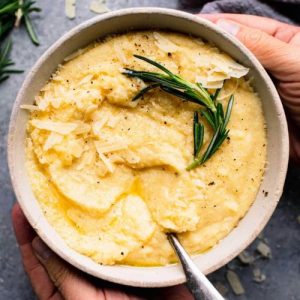
Creamy Parmesan Polenta
Smooth, creamy, and perfectly cheesy, this Parmesan Polenta is a cozy side dish made with just five basic ingredients. It’s hearty yet light, ready in about 25 minutes, and pairs beautifully with roasted vegetables, grilled meats, or stews. Simple, satisfying, and always crowd-pleasing!
Equipment
- 1 medium saucepan (for simmering polenta)
- 1 whisk or wooden spoon (for stirring)
- 1 measuring cup set (for accurate proportions)
- 1 grater (for fresh parmesan)
- 1 ladle (optional, for serving)
Ingredients
- 2 ½ cups chicken broth or vegetable broth or bone broth
- 1 cup milk whole or low-fat
- 1 cup polenta medium or coarse ground cornmeal
- 2 tablespoons unsalted butter
- ½ cup freshly grated parmesan cheese
- Salt and black pepper to taste
Instructions
- Warm the Liquid Base: Begin by combining chicken broth (or your choice of bone or vegetable broth) and milk in a medium-sized saucepan. Set the pan over medium-high heat and season the mixture lightly with salt and freshly ground black pepper. This step forms the flavorful foundation for your polenta, so using a rich broth makes a big difference. Stir occasionally as the mixture heats, and allow it to come just to a gentle simmer—tiny bubbles should appear around the edges, but it shouldn’t be boiling rapidly. This ensures that the polenta will cook evenly and absorb flavor without scalding the milk.
- Gradually Add the Polenta: Once your liquid is gently simmering, slowly pour in the polenta in a thin, steady stream. As you pour, whisk continuously to prevent lumps from forming. This is one of the most important steps—adding the polenta too quickly can lead to clumping, which will make the texture gritty rather than smooth. Stirring as you go allows the cornmeal to disperse evenly and begin absorbing the liquid right away. Continue whisking for the first 2–3 minutes until the mixture starts to thicken slightly and you can feel resistance when stirring.
- Simmer Low and Slow: Once the polenta has been fully incorporated, reduce the heat to low. At this stage, the mixture should bubble slowly, almost like a soft burble rather than a boil. Continue cooking uncovered, stirring every few minutes to prevent sticking and ensure even consistency. Polenta naturally thickens as it cooks, and the starches in the cornmeal release to create a creamy, cohesive texture. This stage usually takes about 20 minutes, but depending on the grind of your polenta, it may take a bit longer. The finished texture should be thick and smooth, easily pulling away from the sides of the pan when stirred.
- Adjust the Consistency: As the polenta nears completion, pay attention to its consistency. If it becomes too thick or starts to pull together in heavy clumps, gently stir in a splash of warm broth or milk, one tablespoon at a time, until it reaches your desired creaminess. The perfect polenta should be soft enough to spoon easily but thick enough to hold its shape on a plate. Don’t rush this process—slow simmering helps the grains fully hydrate and results in a silky, luxurious texture.
- Enrich with Butter and Cheese: When the polenta is fully cooked and velvety smooth, remove the pan from heat. Add the unsalted butter and freshly grated parmesan cheese directly into the hot mixture. Stir slowly and consistently until both the butter and cheese have completely melted and blended in. This final step adds incredible richness, depth, and a delicate, nutty flavor from the parmesan. The heat of the polenta will naturally melt the ingredients, leaving a glossy, creamy finish. Taste and adjust seasoning with additional salt or pepper as needed.
- Serve Warm and Enjoy: Once everything is perfectly incorporated, spoon the creamy Parmesan Polenta into serving bowls or onto plates while still warm. It’s best served immediately while the texture is soft and spoonable. If desired, drizzle with a touch of olive oil, sprinkle extra parmesan on top, or garnish with a pinch of freshly cracked pepper or chopped herbs like parsley or thyme. This dish pairs beautifully with roasted vegetables, grilled meats, braised dishes, or sautéed mushrooms.
Notes
- Use a heavy-bottomed saucepan to prevent the polenta from scorching or sticking.
- Whisk constantly when adding the polenta to avoid lumps and ensure a smooth, creamy base.
- For deeper flavor, try bone broth or vegetable stock instead of plain water.
- Freshly grated parmesan melts better and gives a richer taste than pre-shredded cheese.
- If the mixture thickens too much, add a splash of milk or broth to loosen it to your liking.
- Unsalted butter allows you to control the salt level perfectly.
- Leftovers can be cooled, sliced, and grilled or baked for a delicious new texture the next day.